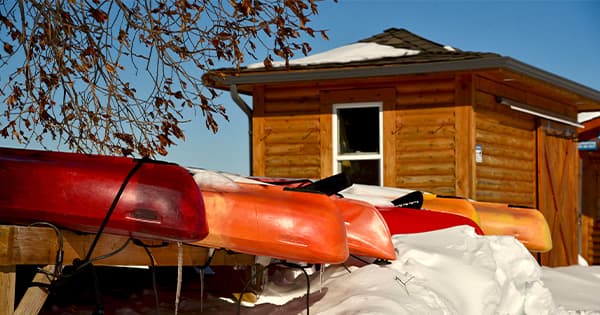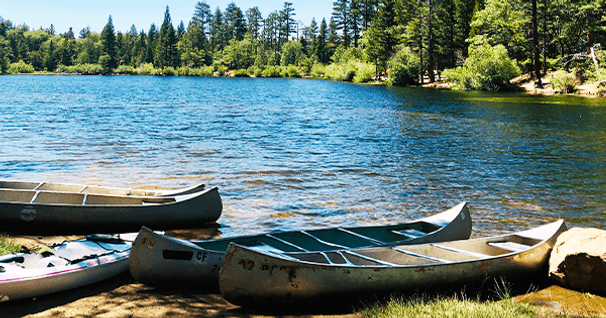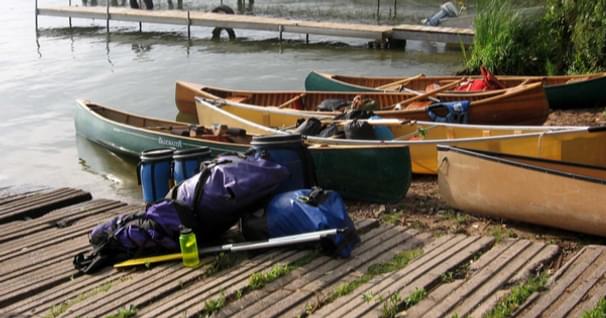Post Season Pack-In: Boat and Gear Maintenance and Storage Tips
Don’t get stuck next spring with gear that’s not ready to go. So many of us finish one thing and move too quickly onto the next. Before you pull out your skis, take a moment to dry, repair and store your paddling gear and boat(s) properly. Proper maintenance and careful storage of your gear will have it outlast its intended lifetime.

Maintaining and Storing Your Soft Gear
Take inventory and take the time to repair any issues at the end of the season so your stuff is ready to go. An end of season gear check allows you to fix or replace gear before the spring. Gear Aid Tenacious Tape is a great option for small holes and tears in your soft gear so they don’t get bigger.
PFD’s, wetsuits, drysuits, ropes, and paddling accessories should be stored clean and dry in a rodent-free location. Ideally, you will store this gear indoors where there are not huge swings in temperature.
Maintaining and Storing Your Boats
Boats are large, especially canoes and sea kayaks. One of the challenges with owning canoes and kayaks is what to do with them when you are not using them. Do they come in the house or apartment? Take up half the garage? Too often they are left out in the cold to fend for themselves against the elements, unloaded after the last paddling trip of the season and left lying around in the sun, neglected.
Like your soft gear you should give your boat an end of season check and fix any issues before storage. The offseason, when you are not using your boat, is the perfect time to do repairs and maintenance.
Check
Seats, Yokes, Hatch Covers etc.
Check wooden parts for slivers, cracks and wear on the finish. Sand down any rough spots and put on a few fresh coats of oil or varnish. Tighten any loose screws or bolts. Replace any worn out webbing.
Painters and Grab Loops
If your boat will be stored outdoors, take off any rope or webbing that will deteriorate from sun, heat and moisture or you will likely have to replace it in the spring. If your boat will be stored indoors, replace any worn or rotten rope or webbing so your boat is ready to go.
Hull
This is a great time of year to plan and complete any needed hull repair since you wont need your boat for a while. This will probably require the use of epoxy resin or plastic welding. If weather permits you can do hull repairs outside, but more than likely you will need a climate controlled indoor space.
Boat Storage
The ideal storage situation for your boat is to be hanging in a cradle of some type, out of the sun, in a climate controlled space with low humidity and normal room temperatures. Unfortunately most of us don’t have a humidor big enough to store our boats. Boats can be stored well outdoors or in a shed or garage that is not climate controlled. Here is what’s important…
Keep them out of the Sun and Heat
Sun, heat and moisture are the three main things to protect your boat from during storage. UV rays can wreak havoc on boat materials especially plastics which break down and deteriorate over time in the sun. Heat can also deteriorate the materials in your boat, causing warping and deformation.
Obviously, an indoor space or shed is the easiest way to get your boat out of the sun. But beware of heat. A barn with little circulation can get extremely hot, an open shed or a simple tarp may be better.
If you must store your boat outside, find a spot out of the sun, off the ground where snow and ice won't fall on it.
Store boats off the Ground
There are various ways to get your boat up off the ground. A shelf built with wood or cradle made from rope or webbing works great. Hanging the boat from grab loops or other anchors built into the boat is also an excellent solution.
The problem with the boat sitting on the ground or hull down on a hard shelf is that the weight of the boat is sitting on part of the hull for a long period of time. This can cause flattening or warping of the hull. Another issue is moisture. If your boat has wooden parts they will begin to rot quickly if stored in contact with the ground. Finally if space is an issue getting the boat off the ground can help.
Ideally, you can hang your boat. There are many commercial hanging systems. Whether you buy something ready to go or create your own, use wide material (at least a couple inches) under the hull of the boat to spread the weight of the boat over as large a surface area as possible. In order to save space, it’s a great idea to get your boat up high in the rafters of your garage or against the ceiling of your bedroom. Make sure you can get it up and down safely – without hurting yourself or your home.
If you don’t have a ceiling or other anchor to hang from, build or buy racks that are padded and will spread the weight of the boat over as big an area as possible.
If you must store your boat on the ground or on a hard surface, store it upside down. This way a canoe will sit on the gunwales and a kayak on the cockpit, reducing the potential of finding your boat with a flat spot or warped hull when you take it out of storage.
Don’t miss out on the first paddling trip of the year because your gear is full of mouse holes or your boat still has that leak from last season. Take some time this fall to fix up any issues. Put some care into storing your boat(s) - I've seen boats that take more wear and tear in storage than on the water. Store your gear properly so that you're ready to paddle when the snow melts.
Inspired by wanderlust and a passion for rivers, Adrian's paddling addiction has taken him across the globe. After pursuing his degree in Outdoor Recreation and Tourism Management, Adrian eventually settled in Palmer Rapids, Ontario. Here, he has worked for over a decade as the Director Of Operations at The Boundless School.
Related Articles
For some of us, storing our canoe or kayak is as simple as dropping it off alongside the garage or…
We are talking about a heavy cast iron pot, not the prank you pulled on your sibling when sharing a bed…
Remember when you bought your first car? Or maybe it was a bike. You may have chosen it for its color,…
You may recall Abraham Maslow ‘s hierarchy of needs from ninth grade social studies. Maslow says, you…



